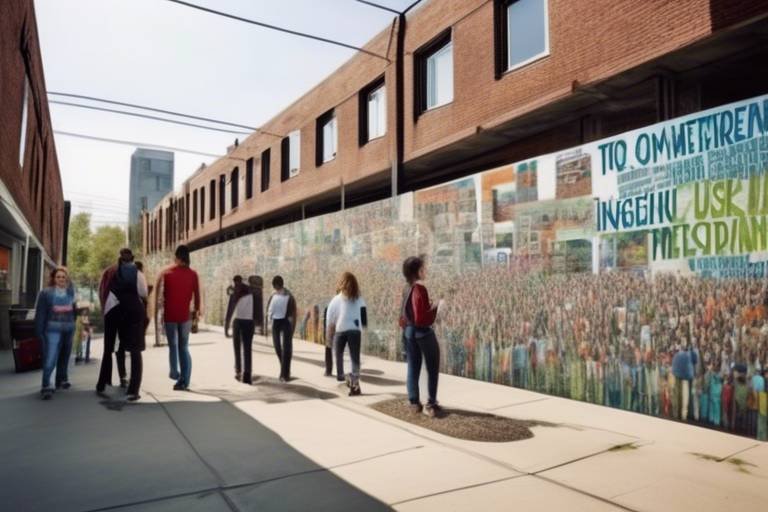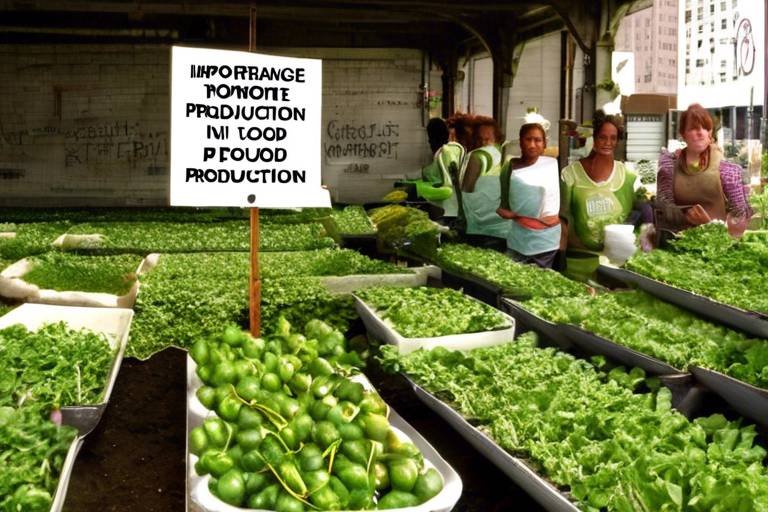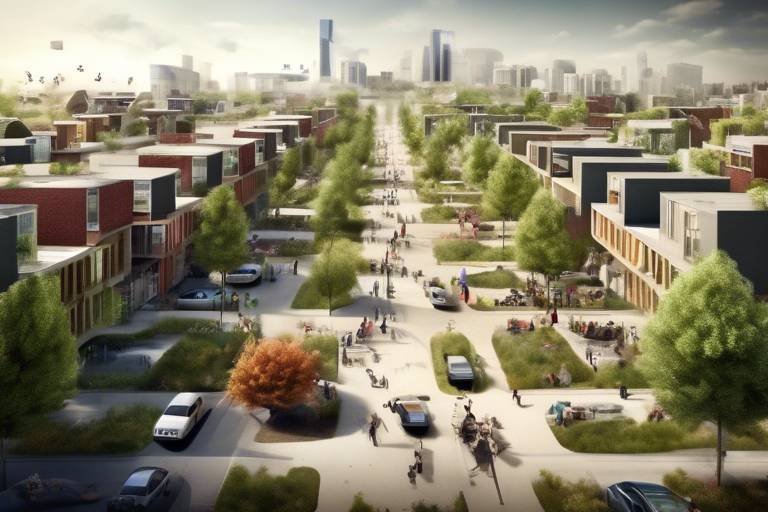Successful Stories of Green City Transitions Globally
In recent years, cities around the globe have embarked on a remarkable journey towards sustainability, transforming urban landscapes into greener, more livable environments. This green transition isn't just a trend; it's a necessity for the well-being of our planet and future generations. From the bustling streets of Copenhagen to the innovative designs in Singapore, cities are reimagining their roles in combating climate change and enhancing the quality of life for their residents. But what does this transformation look like? Let's dive into some inspiring stories of urban areas that have successfully embraced greener practices.
One of the most compelling aspects of these transitions is the way cities are rethinking their urban planning strategies. Innovative urban planning prioritizes green spaces, which not only beautify the city but also improve air quality and provide habitats for wildlife. For instance, cities like Barcelona have integrated parks and green roofs into their infrastructure, creating a network of green corridors that connect neighborhoods. This approach not only reduces pollution but also enhances community well-being by providing residents with access to nature.
Moreover, cities are increasingly adopting renewable energy sources to power their infrastructures. Take San Diego, for example, which has made significant strides in solar energy integration. By installing solar panels on public buildings and encouraging residents to do the same, San Diego has reduced its reliance on fossil fuels significantly. This not only decreases the carbon footprint but also leads to long-term cost savings for both the city and its inhabitants.
Public transportation is another critical area where cities have made impressive improvements. Cities like Amsterdam have transformed their public transport systems into eco-friendly alternatives, promoting cycling and electric buses. This shift not only reduces traffic congestion but also encourages residents to opt for sustainable commuting options, thereby fostering a culture of environmental responsibility. Imagine hopping on a bike instead of a car—it's not just healthier for you; it's a breath of fresh air for the planet!
Community engagement plays a vital role in these transitions. Cities that prioritize community involvement and educational initiatives empower their citizens to take part in sustainability efforts. For instance, Portland has initiated numerous programs that educate residents about recycling, composting, and energy conservation. This grassroots approach fosters a sense of ownership and responsibility among citizens, making them active participants in their city's green journey.
Waste management innovations are also at the forefront of urban sustainability. Cities like Ljubljana have implemented comprehensive recycling programs and composting initiatives that aim to minimize landfill waste. By promoting a circular economy, Ljubljana has set an example for others to follow, demonstrating that effective waste management is not only possible but essential for a sustainable future.
Another crucial aspect of green city transitions is the adoption of green building practices. Cities are increasingly recognizing the importance of sustainable architecture that emphasizes energy efficiency and the use of eco-friendly materials. For example, Vancouver has established strict building codes that require new constructions to meet high sustainability standards, significantly reducing the environmental impact of urban development.
Water conservation is yet another vital area where cities are making strides. With water scarcity becoming an alarming global issue, cities like Melbourne are implementing innovative technologies and community programs aimed at promoting sustainable water usage. From rainwater harvesting systems to public awareness campaigns, Melbourne is leading the way in ensuring that water resources are conserved for future generations.
As cities face the looming threat of climate change, many are proactively developing climate resilience strategies. These strategies are designed to protect infrastructure, enhance biodiversity, and mitigate environmental risks. For instance, New York City has invested in green infrastructure projects that not only improve stormwater management but also provide recreational spaces for residents. This multifaceted approach highlights the interconnectedness of urban planning and environmental sustainability.
In conclusion, the successful stories of green city transitions globally illustrate that change is not only possible but also imperative. Each city, with its unique challenges and opportunities, is contributing to a larger narrative of sustainability and resilience. As we look towards the future, these examples serve as a beacon of hope and inspiration for urban areas worldwide.
- What are green city transitions? Green city transitions refer to the efforts made by urban areas to adopt sustainable practices that enhance environmental health, reduce carbon footprints, and improve the quality of life for residents.
- Why are green city transitions important? They are crucial for combating climate change, conserving resources, and ensuring a livable environment for future generations.
- How can residents participate in their city's green initiatives? Residents can engage by participating in community programs, adopting sustainable practices at home, and advocating for environmentally friendly policies.

Innovative Urban Planning
Urban planning is undergoing a revolutionary transformation as cities around the globe strive to become more sustainable and livable. The traditional model of sprawling urban landscapes is being replaced with a vision that prioritizes green spaces, reduces pollution, and enhances the quality of life for residents. Imagine walking through a city where parks are abundant, air quality is improved, and community engagement is at the forefront of development. This is not just a dream; it's becoming a reality in many urban areas.
One of the key aspects of innovative urban planning is the integration of green infrastructure. Cities like Copenhagen and Singapore have successfully incorporated parks, green roofs, and vertical gardens into their urban landscapes. These features not only beautify the city but also provide essential benefits such as stormwater management, biodiversity enhancement, and improved air quality. For instance, in Singapore, the famous Gardens by the Bay showcases how urban spaces can be transformed into lush, green environments that serve both aesthetic and ecological purposes.
Moreover, cities are increasingly adopting sustainable design principles that focus on mixed-use developments. This approach encourages a blend of residential, commercial, and recreational spaces, reducing the need for long commutes and fostering a sense of community. Imagine living in a neighborhood where you can walk to work, grab groceries, and enjoy a park—all within a few blocks! This not only minimizes the reliance on cars but also promotes healthier lifestyles and stronger community ties.
Another innovative strategy is the implementation of smart city technologies. By utilizing data and technology, cities can optimize their infrastructure and services. For example, intelligent traffic systems can reduce congestion and improve air quality by managing traffic flow more efficiently. Additionally, cities like Barcelona are using sensors to monitor environmental conditions, allowing for real-time adjustments to improve urban living.
While these advancements are promising, they also come with challenges. Urban planners must navigate complex social, economic, and environmental factors to create solutions that are equitable and inclusive. Engaging with the community is essential in this process, ensuring that the voices of residents are heard and considered in planning decisions. This participatory approach not only fosters trust but also leads to more successful outcomes as communities are more likely to support initiatives they helped shape.
In summary, innovative urban planning is paving the way for greener, more sustainable cities. By prioritizing green spaces, embracing sustainable design, and leveraging technology, urban areas are becoming places where people can thrive. As we look to the future, it's clear that the cities that invest in these practices will be the ones that stand out as leaders in the global movement towards sustainability.
- What is innovative urban planning? Innovative urban planning refers to the strategies and practices that cities adopt to create sustainable, livable urban environments through green infrastructure, smart technologies, and community engagement.
- Why is green infrastructure important? Green infrastructure helps manage stormwater, improves air quality, and enhances biodiversity, making cities healthier and more resilient.
- How can communities get involved in urban planning? Communities can participate by attending public meetings, providing feedback on plans, and engaging with local government officials to express their needs and ideas.

Renewable Energy Adoption
In an era where climate change looms large, cities around the globe are stepping up to the plate, embracing renewable energy as a cornerstone of their sustainability strategies. Imagine a city where the sun not only shines but also powers homes and businesses, where the wind whispers through the turbines, generating clean energy. This transformation is not just a dream; it's becoming a reality in many urban centers.
Take San Diego, for example. This Californian city has made remarkable strides in integrating renewable energy into its infrastructure. With a commitment to achieving 100% renewable energy by 2035, San Diego has implemented a range of initiatives, including expansive solar panel installations on rooftops and community solar projects. This not only reduces reliance on fossil fuels but also creates local jobs and stimulates the economy.
Another shining example is Copenhagen, a city that has embraced wind energy with open arms. Currently, over 40% of its energy comes from wind turbines, and the city aims to become carbon neutral by 2025. The Danish capital has invested heavily in offshore wind farms, demonstrating how urban areas can harness natural resources effectively. The result? A cleaner environment and a model for other cities to follow.
But what does this mean for residents? By adopting renewable energy, cities are not just reducing their carbon footprints; they are also enhancing the quality of life for their citizens. Cleaner air, reduced energy costs, and increased energy independence are just a few benefits that come from this transition. Moreover, cities like Barcelona are leading the way in promoting solar energy through regulations that require new buildings to install solar panels, making renewable energy accessible to all.
However, the journey to renewable energy adoption is not without its challenges. Cities must navigate financial hurdles, regulatory frameworks, and community buy-in. A prime example is Los Angeles, which faced significant pushback when proposing a major solar initiative. Through persistent community engagement and education, the city was able to shift public perception, ultimately leading to successful implementation.
To further understand the impact of renewable energy adoption, let’s take a look at some key statistics:
| City | Renewable Energy Target | Current Renewable Energy Percentage |
|---|---|---|
| San Diego | 100% by 2035 | 40% |
| Copenhagen | Carbon Neutral by 2025 | 40% |
| Los Angeles | 50% by 2030 | 30% |
As cities continue to innovate and push the boundaries of what's possible, the future looks bright for renewable energy. The transition to sustainable practices is not just an environmental necessity; it’s a pathway to a healthier, more resilient urban life. So, the next time you see a solar panel or a wind turbine, remember that they are not just structures; they are symbols of a greener future.
- What are the main benefits of renewable energy adoption in cities?
Renewable energy adoption leads to reduced greenhouse gas emissions, improved air quality, lower energy costs, and increased energy security.
- How can residents support renewable energy initiatives?
Residents can support these initiatives by participating in community programs, advocating for policies that promote renewable energy, and considering solar installations for their homes.
- Are there any financial incentives for cities to adopt renewable energy?
Yes, many governments offer grants, tax credits, and subsidies to encourage cities to invest in renewable energy projects.

Public Transportation Enhancements
In recent years, cities around the globe have recognized that public transportation is not just a means to get from point A to point B; it’s a vital component of urban sustainability. Enhancing public transportation systems can significantly reduce traffic congestion, lower greenhouse gas emissions, and promote a more livable urban environment. But how are cities achieving this? Let’s dive into some innovative strategies that are transforming public transit into a greener, more efficient option.
One of the most exciting developments in public transportation is the integration of electric buses and trams. Cities like Los Angeles and Amsterdam have made substantial investments in electric fleets, which not only cut down on air pollution but also provide a quieter and more comfortable ride for passengers. Imagine hopping on a bus that runs silently, powered by renewable energy, instead of the noisy, gas-guzzling alternatives of the past. It’s a game-changer!
Moreover, cities are reimagining their transit networks by implementing smart technology. Real-time tracking apps allow commuters to know exactly when their bus or train will arrive, minimizing wait times and enhancing the overall experience. This technology fosters a sense of reliability and encourages more people to ditch their cars in favor of public transport. In fact, a study showed that cities with real-time tracking systems saw a 15% increase in public transit usage.
Another critical aspect of enhancing public transportation is the development of multi-modal transit hubs. These hubs serve as central points where various modes of transport—like buses, trains, bicycles, and even ride-sharing services—interconnect seamlessly. For instance, in Tokyo, the Shinjuku Station is a prime example of how effective design can lead to a smooth transition between different forms of transport. This not only improves accessibility for users but also encourages a more sustainable commuting culture.
Furthermore, cities are investing in dedicated bike lanes and pedestrian-friendly pathways to complement their public transport systems. By making it easier and safer for people to walk or cycle to transit stations, cities can reduce their overall carbon footprint. In Copenhagen, for example, the city has prioritized cycling infrastructure, resulting in over 40% of its residents commuting by bike. This approach not only promotes public transport but also contributes to healthier lifestyles.
To summarize, public transportation enhancements are crucial for fostering sustainable urban living. By investing in electric vehicles, smart technology, multi-modal hubs, and bike-friendly infrastructure, cities are paving the way for a greener, more efficient future. The question remains: will your city follow suit? As urban populations continue to grow, the need for effective public transportation solutions has never been more pressing.
- What are the benefits of enhancing public transportation?
Enhancing public transportation can lead to reduced traffic congestion, lower emissions, and improved air quality, making cities more livable. - How do electric buses impact the environment?
Electric buses produce zero tailpipe emissions, significantly reducing air pollution compared to traditional diesel buses. - What role does technology play in public transportation?
Smart technology, such as real-time tracking apps, enhances the user experience and encourages more people to use public transport. - Can cycling infrastructure improve public transportation?
Yes! Safe bike lanes and pedestrian pathways encourage people to cycle to transit stations, thereby increasing public transport usage.

Community Engagement and Education
When it comes to transitioning to a greener city, the role of community engagement and education cannot be overstated. Imagine a city where every resident feels empowered to contribute to sustainability efforts. This vision is becoming a reality in many urban areas worldwide, where local governments and organizations are actively involving citizens in their green initiatives. Why is this important? Because a city thrives when its residents are engaged and educated about the environmental challenges they face and the solutions available to them.
One of the most effective ways to foster this engagement is through educational programs that inform citizens about sustainability practices. From workshops on composting to seminars on energy conservation, cities are implementing a variety of initiatives aimed at raising awareness. These programs often encourage participation by highlighting the personal benefits of sustainable living, such as cost savings and improved health. For instance, cities like San Francisco have seen a remarkable increase in recycling rates, thanks to community education efforts that make recycling easy and accessible.
Moreover, community engagement goes beyond just education; it involves actively involving residents in decision-making processes. Many cities are now hosting town hall meetings, where citizens can voice their opinions on proposed sustainability projects. This participatory approach not only empowers residents but also ensures that the initiatives reflect the community's needs and values. After all, who knows a neighborhood better than the people who live there?
In addition to formal educational programs, community gardens and local clean-up events serve as hands-on learning experiences. These initiatives not only beautify urban areas but also teach residents about the importance of biodiversity and maintaining green spaces. When people work together to plant trees or clean up parks, they develop a sense of ownership and pride in their environment. This camaraderie fosters a culture of sustainability that permeates throughout the community.
To illustrate the impact of community engagement and education, let’s take a look at a few successful examples:
| City | Initiative | Outcome |
|---|---|---|
| Portland, Oregon | Neighborhood Sustainability Grants | Increased community-led green projects, improved local ecosystems. |
| Copenhagen, Denmark | Green School Programs | Enhanced student awareness and participation in sustainability. |
| Melbourne, Australia | Community Climate Action Plans | Empowered residents to develop local climate solutions. |
These examples show that when communities are educated and engaged, they can drive substantial change. However, the journey does not end here. Continuous education is vital to adapting to new challenges and innovations in sustainability. Cities must invest in ongoing training and resources to keep their citizens informed and motivated.
As urban areas continue to grow, the need for sustainable practices becomes more pressing. By fostering a culture of engagement and education, cities can ensure that their residents are not just passive observers but active participants in creating a greener future. After all, a city is only as strong as its community, and when that community is committed to sustainability, the possibilities are endless.
- What are some effective ways to engage my community in sustainability efforts? Hosting workshops, community gardens, and clean-up events are great starting points.
- How can I educate myself about sustainable practices? Look for local programs, online courses, and community resources that focus on sustainability.
- Why is community involvement important for green initiatives? Community involvement ensures that sustainability efforts reflect local needs and fosters a sense of ownership among residents.

Waste Management Innovations
In the quest for a greener future, cities around the globe are increasingly recognizing the importance of . The way we handle waste not only impacts our environment but also shapes the quality of urban life. Imagine a city where waste is not merely discarded but transformed into valuable resources. This is not just a dream; it's a reality being crafted by forward-thinking municipalities.
One of the most exciting developments in waste management is the implementation of smart waste collection systems. These systems utilize technology such as sensors and IoT (Internet of Things) devices to monitor waste levels in bins across the city. This allows for optimized collection routes, reducing fuel consumption and emissions. For instance, cities like Barcelona have adopted such systems, which not only improve efficiency but also encourage responsible waste disposal among residents.
Another innovative approach is the promotion of circular economy principles. Instead of following the traditional linear model of "take, make, dispose," cities are now striving to create systems where waste is minimized, and materials are reused or recycled. For example, San Francisco has set ambitious goals to achieve zero waste by 2030. They have implemented extensive recycling and composting programs, diverting a significant portion of waste from landfills. This not only reduces environmental impact but also creates jobs and stimulates the local economy.
Composting is another vital aspect of modern waste management. By encouraging residents to compost organic waste, cities can drastically cut down on landfill contributions. For instance, Portland, Oregon, has successfully integrated composting into its waste management strategy, resulting in a significant decrease in waste sent to landfills. This initiative not only helps the environment but also educates citizens about the benefits of recycling organic materials.
Furthermore, the concept of waste-to-energy (WtE) facilities is gaining traction. These facilities convert non-recyclable waste materials into usable energy through various processes, including combustion, gasification, and anaerobic digestion. Cities like Amsterdam have embraced this technology, turning waste into electricity and heat while reducing their reliance on fossil fuels. This dual benefit of waste management—reducing landfill use while generating energy—is a win-win for urban sustainability.
However, implementing these innovations is not without challenges. Cities must engage in comprehensive public education campaigns to ensure that residents understand and participate in new waste management practices. It's essential to foster a sense of community responsibility towards waste reduction. For instance, Tokyo has a well-established waste sorting system that relies heavily on community participation. The city's residents are educated on how to separate their waste properly, which has led to one of the highest recycling rates in the world.
In conclusion, the landscape of waste management is evolving rapidly, with cities worldwide adopting innovative strategies to tackle the pressing issue of waste. From smart collection systems to circular economy practices and waste-to-energy solutions, the future of urban waste management is bright. As we continue to innovate and engage our communities, we can pave the way for a cleaner, more sustainable urban environment.
- What are waste management innovations? Waste management innovations refer to new technologies and strategies implemented to improve the efficiency and effectiveness of waste collection, recycling, and disposal.
- How can cities promote recycling? Cities can promote recycling through public education campaigns, providing accessible recycling bins, and implementing mandatory recycling laws.
- What is a circular economy? A circular economy is an economic model that emphasizes reusing, recycling, and reducing waste to create a sustainable system where resources are kept in use for as long as possible.

Green Building Practices
In recent years, the concept of has gained significant traction as cities around the globe strive to reduce their environmental impact. These practices not only focus on energy efficiency but also prioritize the use of sustainable materials and innovative design principles. Imagine living in a space that not only feels good but also does good for the planet! That’s the beauty of green buildings.
At the heart of green building is the idea of sustainability. This means constructing buildings that are designed to minimize their carbon footprint while maximizing energy efficiency. One of the key elements in this movement is the use of renewable materials, such as bamboo, reclaimed wood, and recycled steel, which contribute to a reduced environmental impact. Additionally, architects and builders are increasingly incorporating smart technologies that optimize energy use, such as energy-efficient lighting, advanced HVAC systems, and solar panels.
Moreover, green buildings often feature green roofs and walls, which not only enhance aesthetic appeal but also provide insulation, reduce heat absorption, and promote biodiversity. Think of it as creating a small ecosystem right on top of a building! These green spaces can help mitigate the urban heat island effect, making city living more comfortable during the warmer months.
To put the impact of these practices into perspective, let's take a look at some statistics:
| Aspect | Traditional Buildings | Green Buildings |
|---|---|---|
| Energy Consumption | 100% | 30-50% Less |
| Water Usage | 100% | 20-30% Less |
| Carbon Emissions | 100% | 30-40% Less |
As we can see from the table, the benefits of green building practices are not just theoretical; they translate into real-world savings and reductions in environmental impact. But how do cities encourage these practices? Many local governments offer incentives for developers who incorporate green technologies and materials into their projects. These can include tax breaks, expedited permitting processes, and grants for sustainable initiatives.
Community engagement is also crucial in promoting green building practices. Residents are becoming more aware of the importance of sustainability and are often vocal about their preferences for eco-friendly developments. This shift in public opinion is prompting more developers to adopt green practices, creating a positive feedback loop that benefits everyone involved.
In conclusion, the rise of green building practices represents a significant shift in how we think about urban development. By prioritizing sustainability, cities can create healthier, more resilient environments for their residents. As we continue to innovate and push the boundaries of what’s possible, the potential for greener, more sustainable urban living is not just a dream—it’s becoming a reality!
- What are green building practices? Green building practices refer to the design, construction, and operation of buildings that are environmentally responsible and resource-efficient throughout their life cycle.
- Why are green buildings important? They help reduce energy and water consumption, lower carbon emissions, and create healthier living environments for occupants.
- What materials are commonly used in green buildings? Common materials include recycled steel, bamboo, reclaimed wood, and low-VOC (volatile organic compound) paints and finishes.
- How can I make my home more sustainable? You can start by using energy-efficient appliances, incorporating renewable energy sources like solar panels, and using sustainable materials in renovations.

Water Conservation Efforts
Water is the essence of life, and as urban areas continue to expand, the demand for this precious resource skyrockets. Cities around the globe are facing a critical challenge: how to conserve water while ensuring that their growing populations have access to it. Fortunately, many cities are stepping up to the plate, implementing innovative water conservation strategies that not only address scarcity but also promote sustainable usage. Let's dive into some of the most effective efforts that are making waves in urban water management.
One of the standout cities in this arena is Singapore, known for its comprehensive approach to water sustainability. The city-state has developed a multifaceted water management strategy that includes rainwater harvesting, wastewater recycling, and the use of advanced desalination technologies. Singapore's NEWater initiative, which treats and purifies wastewater to drinking standards, is a prime example of innovation in action. This initiative not only reduces the city's reliance on imported water but also educates citizens about the importance of water conservation.
In addition to technological advancements, community engagement plays a pivotal role in water conservation efforts. Cities like Los Angeles have launched programs that encourage residents to adopt water-saving practices at home. The city promotes the installation of low-flow fixtures, drought-tolerant landscaping, and rain barrels through incentive programs. By actively involving the community, LA has seen a significant reduction in water consumption, demonstrating that when people understand the importance of conservation, they are more likely to change their habits.
Moreover, cities are increasingly utilizing data and smart technology to monitor water usage and detect leaks. For instance, Barcelona has implemented a smart water management system that uses sensors to track water flow and identify inefficiencies in real-time. This proactive approach not only helps in conserving water but also reduces operational costs for the city. By adopting such technologies, cities can ensure that every drop counts, making their water management systems more efficient and sustainable.
Another crucial aspect of water conservation is education. Cities are recognizing the need to educate their citizens about the value of water and the impact of their choices. Programs aimed at schools and community organizations are essential in fostering a culture of conservation. For example, Melbourne has introduced educational campaigns that teach residents about the water cycle, the importance of sustainable practices, and how to reduce their water footprint. These initiatives empower individuals to make informed decisions and contribute to the overall goal of water sustainability.
To further illustrate the impact of these efforts, let's take a look at a comparison of water conservation results in various cities:
| City | Water Conservation Strategy | Results |
|---|---|---|
| Singapore | NEWater initiative and rainwater harvesting | Reduced reliance on imported water by 40% |
| Los Angeles | Incentives for low-flow fixtures and drought-tolerant landscaping | 25% reduction in water consumption over 5 years |
| Barcelona | Smart water management system | 30% decrease in water loss due to leaks |
| Melbourne | Educational campaigns on water conservation | Increased awareness led to a 15% decrease in household water use |
In conclusion, the journey towards effective water conservation is not just about implementing technologies or policies; it’s about creating a community that values and respects water as a vital resource. As cities continue to innovate and engage their citizens, the results speak for themselves. By learning from these successful examples, other urban areas can adopt similar strategies, ensuring a sustainable future for generations to come.
- Why is water conservation important? Water conservation is crucial for sustaining our ecosystems, ensuring water availability for future generations, and reducing the energy required for water treatment and distribution.
- What are some simple ways to conserve water at home? Simple methods include fixing leaks, using water-efficient appliances, taking shorter showers, and collecting rainwater for gardening.
- How can communities get involved in water conservation efforts? Communities can participate through educational programs, local conservation initiatives, and by advocating for sustainable water policies.

Climate Resilience Strategies
As the effects of climate change become increasingly evident, cities around the globe are stepping up their game with that not only protect their infrastructure but also enhance the quality of life for their residents. Imagine a city that can withstand the fury of storms, the heat of summer, and the unpredictable nature of climate shifts. Sounds like a dream, right? Well, many urban areas are turning this dream into reality through innovative planning and community engagement.
One of the primary components of these climate resilience strategies is the integration of green infrastructure. This approach involves using natural processes to manage water, reduce heat, and improve air quality. For instance, cities are incorporating green roofs and permeable pavements to absorb rainwater, which can significantly reduce the risk of flooding. These solutions not only help manage stormwater but also create green spaces that promote biodiversity and enhance urban aesthetics.
Another key strategy is the development of urban heat island mitigation techniques. Urban areas are often hotter than their rural counterparts due to human activities and infrastructure. To combat this, cities are planting more trees, creating parks, and using reflective materials in buildings and roads. This not only cools the environment but also improves air quality, making the city more livable. It’s like giving the city a refreshing drink on a hot day!
Moreover, cities are investing in early warning systems and robust emergency response plans to prepare for extreme weather events. These systems utilize technology to monitor weather patterns and alert residents about impending disasters, allowing them to take necessary precautions. For example, cities like Miami have implemented advanced forecasting systems that keep citizens informed about hurricanes and flooding, ensuring that they can act swiftly to protect themselves and their property.
In addition to physical infrastructure, community engagement plays a crucial role in enhancing climate resilience. When residents are educated and involved in sustainability practices, they become more aware of the challenges posed by climate change and are better prepared to respond. Educational programs that promote sustainable practices, such as water conservation and energy efficiency, empower citizens to make informed decisions that contribute to the overall resilience of their community.
To illustrate the effectiveness of these strategies, let’s take a look at some cities that are leading the way:
| City | Climate Resilience Strategy | Impact |
|---|---|---|
| New York City | Green infrastructure initiatives like the NYC Green Roofs program | Reduced stormwater runoff and improved air quality |
| Tokyo | Advanced earthquake-resistant infrastructure | Minimized damage during seismic events |
| Amsterdam | Innovative water management and flood control systems | Enhanced flood resilience |
As we can see, cities are not just sitting back and waiting for climate change to happen; they are actively working to create a future that is sustainable and resilient. By embracing these strategies, they are setting an example for others to follow. The journey toward climate resilience is not without its challenges, but the benefits—such as enhanced public health, economic stability, and improved quality of life—are well worth the effort. So, next time you hear about a city implementing these strategies, remember that they are not just protecting their residents; they are paving the way for a greener, more sustainable future.
- What are climate resilience strategies? These are plans and actions taken by cities to prepare for and adapt to the impacts of climate change.
- Why is community engagement important in climate resilience? Engaging the community ensures that residents are informed and involved in sustainability practices, making them more likely to participate in resilience efforts.
- How do green infrastructures help with climate resilience? They manage stormwater, reduce heat, and improve air quality, making urban areas more livable and sustainable.

Case Studies of Success
When it comes to green city transitions, several cities around the world stand out as shining examples of innovation and commitment to sustainability. These case studies not only showcase the remarkable achievements of urban planners and community members but also serve as inspiration for other cities looking to embark on their own green journeys. Let's dive into some of these success stories and explore the key initiatives that have led to their transformation.
One of the most notable examples is Copenhagen, Denmark. This city has set ambitious goals to become the world's first carbon-neutral capital by 2025. Through extensive investments in renewable energy, such as wind and solar power, Copenhagen has significantly reduced its carbon emissions. The city has also prioritized cycling as a primary mode of transportation, boasting an extensive network of bike lanes that encourages residents to leave their cars at home. In fact, over 62% of the population uses bicycles daily, making it a model for urban mobility.
Another inspiring case is Curitiba, Brazil, often hailed as a pioneer in sustainable urban planning. The city implemented an innovative bus rapid transit (BRT) system that not only improved public transportation efficiency but also reduced traffic congestion and pollution. This system has made it easier for residents to navigate the city without relying on personal vehicles. Additionally, Curitiba's commitment to green spaces is evident in its numerous parks and gardens, which enhance the quality of life for its citizens.
San Francisco, California, is also making waves with its aggressive waste management policies. The city has adopted a goal of zero waste by 2030, leading to the implementation of comprehensive recycling and composting programs. San Francisco's residents actively participate in these initiatives, contributing to a remarkable diversion rate of over 80% of waste from landfills. This effort not only reduces environmental impact but also fosters a culture of sustainability among the city's inhabitants.
In Europe, Amsterdam, Netherlands, stands out for its commitment to sustainable living. The city has invested heavily in renewable energy, aiming for 50% of its energy needs to come from sustainable sources by 2025. Amsterdam's extensive network of electric vehicle charging stations and incentives for electric bikes further encourage residents to embrace eco-friendly transportation. The city also emphasizes green building practices, with many new developments adhering to strict sustainability standards.
These case studies illustrate that the journey toward a greener city is not a one-size-fits-all approach. Each city has tailored its initiatives to address unique challenges and leverage local strengths. The common thread among these success stories is the engagement of the community—when residents are involved and educated about sustainability practices, the impact is amplified.
As we look to the future, it's crucial to learn from these cities. The lessons learned from their challenges and triumphs can guide other urban areas in their quest for sustainability. By sharing knowledge and experiences, cities can work together to create a more sustainable world.
Q: What are the main benefits of transitioning to a green city?
A: Transitioning to a green city can lead to improved air quality, reduced energy costs, enhanced public health, and increased community engagement. Additionally, it can boost local economies through green jobs and sustainable tourism.
Q: How can communities get involved in their city's green initiatives?
A: Communities can participate by joining local sustainability groups, attending workshops, and advocating for eco-friendly policies. Volunteering for community projects, such as tree planting or clean-up events, also makes a significant impact.
Q: Are there financial incentives for cities to go green?
A: Yes, many governments offer grants, tax incentives, and subsidies for cities that implement sustainable practices, such as renewable energy projects and green infrastructure development.
Frequently Asked Questions
-
What are some examples of cities that have successfully transitioned to greener practices?
Many cities around the globe have made remarkable strides towards sustainability. For instance, Copenhagen has become a leader in renewable energy, aiming to be carbon neutral by 2025. Similarly, Portland is known for its extensive bike lanes and public transportation options that encourage eco-friendly commuting.
-
How do urban planning strategies contribute to sustainability?
Urban planning plays a crucial role in creating green spaces and reducing pollution. By prioritizing parks, green roofs, and pedestrian-friendly areas, cities enhance livability while also combating urban heat and improving air quality. It's like giving the city a breath of fresh air!
-
What renewable energy sources are most commonly adopted by cities?
Many cities are integrating solar and wind energy into their infrastructure. These renewable sources not only reduce reliance on fossil fuels but also help lower greenhouse gas emissions, making urban areas cleaner and more sustainable.
-
How are cities improving public transportation to be more eco-friendly?
Cities are investing in electric buses, expanding rail systems, and enhancing bike-sharing programs to make public transportation more efficient and accessible. This shift encourages residents to leave their cars at home, reducing traffic congestion and pollution.
-
What role does community engagement play in green city transitions?
Community involvement is vital for successful sustainability initiatives. Through educational programs and local events, residents become empowered to take action, whether it’s participating in tree planting or advocating for green policies. It’s all about building a culture of sustainability together!
-
What innovative waste management strategies are cities implementing?
Cities are adopting strategies like recycling programs, composting initiatives, and waste-to-energy technologies. These efforts aim to reduce landfill waste and promote a circular economy, where materials are reused and recycled rather than discarded.
-
How are green building practices changing urban development?
Green building practices focus on energy efficiency, sustainable materials, and minimal environmental impact. This shift not only reduces the carbon footprint of new constructions but also promotes healthier living environments for residents.
-
What are some effective water conservation strategies cities are using?
Many cities are implementing smart technologies for monitoring water usage, promoting rainwater harvesting, and encouraging xeriscaping in landscaping. These strategies help address water scarcity while fostering a culture of conservation among residents.
-
How are cities preparing for climate change?
Cities are developing resilience strategies that include enhancing infrastructure, protecting natural habitats, and implementing policies to mitigate environmental risks. It’s about creating a city that not only survives but thrives in the face of climate challenges!
-
Can you provide examples of successful case studies in green city transitions?
Absolutely! Cities like Amsterdam have embraced cycling as a primary mode of transport, while San Francisco has implemented comprehensive recycling and composting programs. These case studies highlight the innovative solutions and collaborative efforts that can inspire other cities to follow suit.



















